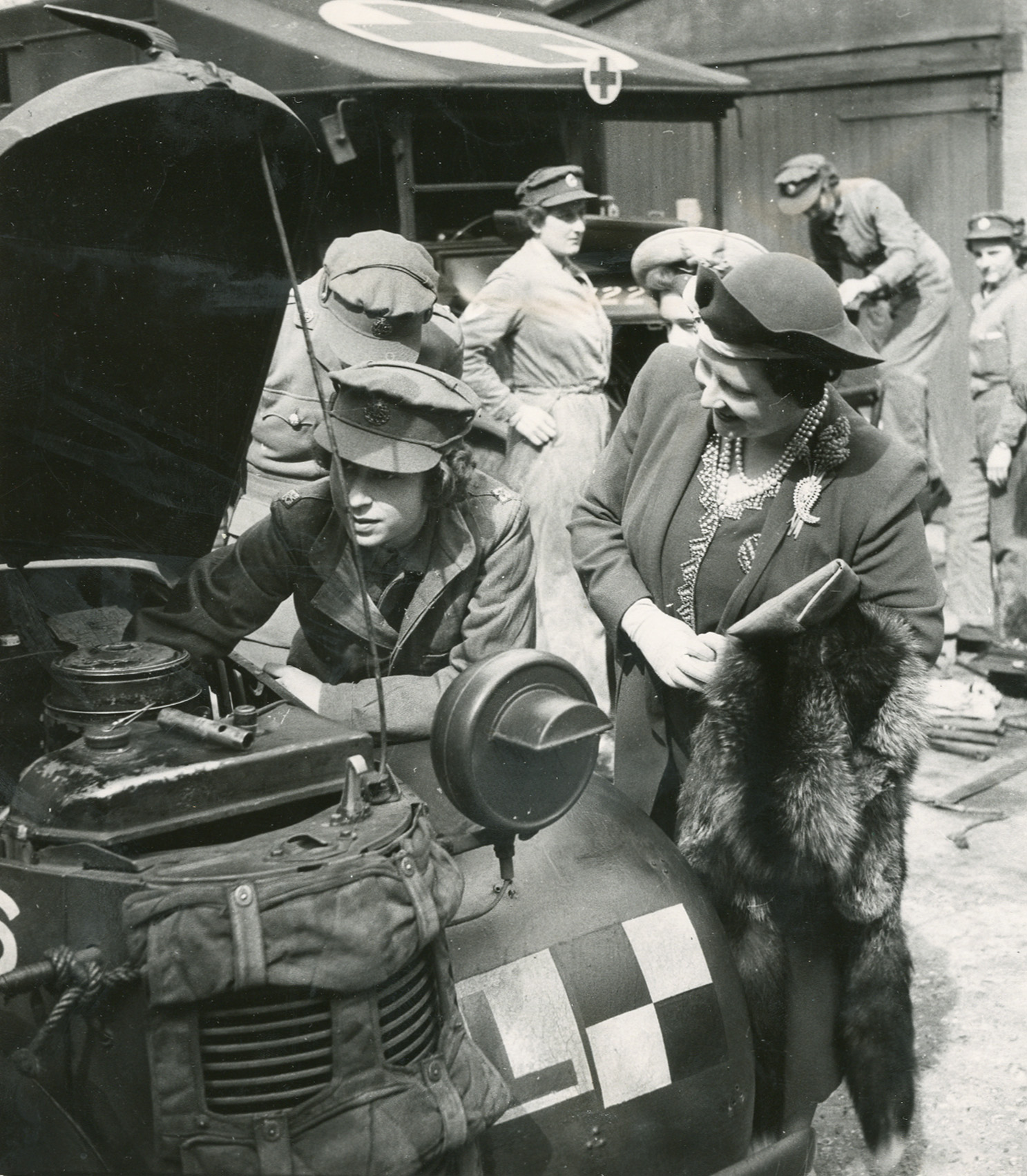
A young female auto mechanic in military uniform in England in 1945 would not have been a rare sight, nor would a photograph of one such woman giving a demonstration to a visiting dignitary. This particular photo, however, is unusual because of what her job was when she wasn’t serving in the Auxiliary Territorial Service (ATS), a women’s army auxiliary branch.
The visiting dignitary is Queen Elizabeth — now perhaps better known as the Queen Mother — and the young ATS subaltern is her daughter, the future Queen Elizabeth II.
The photo is part of the collection displayed in Women in WWII: On the Home Fronts and the Battlefronts, a new exhibition opening Friday at the International Museum of World War II in Natick, Mass. The show takes a wide view of the many roles played by women from every nation involved in the conflict, and this photo is one of the documents in the exhibition that most underlines the active role women sought during the war.
“To me it’s a really interesting example of women’s roles in the war. Women wanted to be part of what was going on. They were a part of what was going on. It fits in with the statement made by Elizabeth’s mother, Queen Elizabeth, that when Buckingham Palace was bombed she felt she could look the East Enders in the eye,” says Kenneth Rendell, the museum’s director.
In 1939, as TIME reported in a cover story on British women at war, the impact of the war on the nation’s women was widespread and immediate. Career girls lost their work as unnecessary businesses shut down, housewives coped with austerity measures, mothers sent their children away to safety in the countryside and thousands signed up to fill auxiliary military roles as well as essential civil jobs, from driving buses to milking cows, that were left vacant as men went into combat. At Buckingham Palace, the older Queen Elizabeth officially became the commandant-in-chief of the Women’s Royal Naval Service, Women’s Auxiliary Air Force and Women’s Auxiliary Territorial Service. Their uniforms, the magazine declared, were “the first warlike garments to be worn by an English Queen since the days of Boadicea.” And her daughters Princess Elizabeth and Princess Margaret were, like so many young Britons, sent away from London for protection from the Blitz.
And, when Princess Elizabeth turned 18 in 1944, LIFE Magazine would report, she advocated for herself to serve the way other young Brits would have to.
“[The] King ruled after long deliberations with his councilors that her training as a princess outweighed the nation’s increasing manpower problems and that ‘Betts’ should not join any of the women’s auxiliaries, nor work in a factory,” the magazine related. “But Betts had other ideas. It was not surprising that not long afterward the Palace made a straight-face announcement that the King ‘had been pleased to grant an honorary commission as second subaltern in the ATS to Her Royal Highness the Princess Elizabeth.'”
The Princess’ desire to serve was in keeping with the overall mood in the her homeland, Rendell says: “People have said to me that the lucky ones were the pilots, because they were doing something.”
Princess Elizabeth, heiress presumptive to the throne, was commissioned as an honorary second subaltern in the ATS — basically the equivalent of a second lieutenant — and began training in March of 1945. Per royal decree from her father the King, she was given no special rank or privilege. (She did later earn a promotion to junior commander.) At the time, the Associated Press reported that she was the first woman in the royal family to be “a full-time active member in the women’s service.”
Though not a combat role, serving in the ATS was not without its risks. The service saw its first death in 1942, when a woman serving at an anti-aircraft station was killed by a bomb. Nor was it something those with privilege sought to avoid; Winston Churchill’s daughter also Mary served in the ATS.
Once she joined up, the Princess passed a military driving test, learned to read maps and worked repairing engines. (She did sleep at Windsor Castle, though, rather than in the camp with her fellow ATS members.)
According to the official War Office caption printed on the back of the photo, the King and Queen and Princess Margaret visited an ATS training center in the south of the country, and watched Princess Elizabeth learn about auto maintenance. In the photo, the Princess explains her work with the engine to the Queen. An Associated Press report on the April 9 visit dubbed the future sovereign “Princess Auto Mechanic.”
In addition to serving the country, she took her time with the ATS as a valuable lesson in what life was like for non-royals — including just what went into the scene shown seen in the photograph above. “I never knew there was quite so much advance preparation [for a royal visit],” LIFE quoted the Princess as saying. “I’ll know another time.”
More Must-Reads from TIME
- Cybersecurity Experts Are Sounding the Alarm on DOGE
- Meet the 2025 Women of the Year
- The Harsh Truth About Disability Inclusion
- Why Do More Young Adults Have Cancer?
- Colman Domingo Leads With Radical Love
- How to Get Better at Doing Things Alone
- Michelle Zauner Stares Down the Darkness
Write to Lily Rothman at lily.rothman@time.com